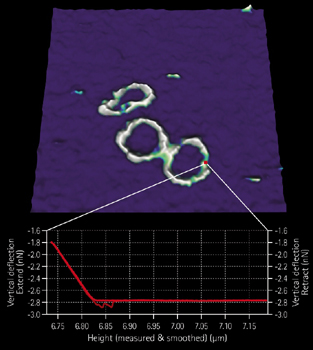JPK Instruments, a world-leading manufacturer of nanoanalytic instrumentation for research in life sciences and soft matter, announce exciting new quantitative imaging capabilities for the recently launched NanoWizard3 AFM system.
 168 bp DNA nano-rings on Poly-L-Ornithine protein layer in buffer solution and force distance curve at the marked point. Scan size: 80 x 80 nm. Z-range: 2.5 nm. Sample imaged in closed-loop with QI capability. Sample courtesy of Dr Damian Ackermann, LIMES, University of Bonn, Germany.
168 bp DNA nano-rings on Poly-L-Ornithine protein layer in buffer solution and force distance curve at the marked point. Scan size: 80 x 80 nm. Z-range: 2.5 nm. Sample imaged in closed-loop with QI capability. Sample courtesy of Dr Damian Ackermann, LIMES, University of Bonn, Germany.
QI is the new quantitative imaging mode from JPK. It has been developed to make AFM imaging easier than ever before. With QI, a force curve-based imaging mode, the user has the full control over the tip-sample force at every pixel of the image. There is no need for setpoint or gain adjustment while scanning. Applying JPK's ForceWatch technology, QI delivers outstanding results on challenging samples such as soft (hydrogels or biomolecules), sticky (polymers or bacteria), loosely attached samples (nanotubes or virus particles in fluid) or samples with steep edges (powders, MEMS structures). QI mode is particularly useful in areas that demand both high resolution and force sensitivity such as biology, polymers and surface science.
The newly developed QI and QI-Advanced modes make the NanoWizard AFM the most versatile instrument for both high-end research and routine use. Compared to other imaging modes, QI delivers real quantitative data. AFM moves from purely imaging to deliver quantitative measurement. To measure a real and complete force distance curve at every pixel of the image gives all information about the local tip-sample interaction with high spatial resolution.
The QI-Advanced software package is an extension of the standard QI version enabling quantitative measurement of nano-scale material properties such as stiffness, adhesion, dissipation and more. Once again, the imaging data is both quantitative and has high spatial resolution.
Speaking about the new QI capability, head of applications and customer support, Heiko Haschke, said: "We designed this software to be straightforward for a beginner to use while also having advanced options to meet the needs of the user who likes to apply their own data processing routines. It is the fact that we are measuring complete force curves at each pixel that provides real utility for the user - easy-to-produce quantitative data."